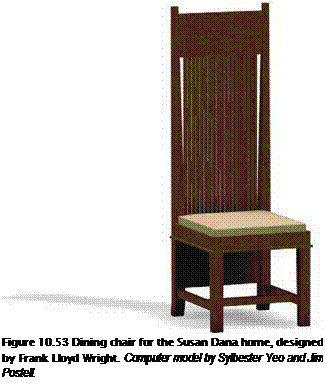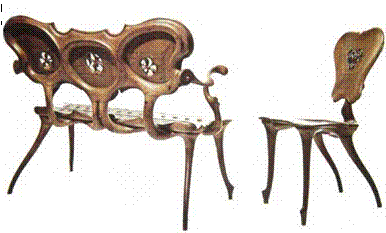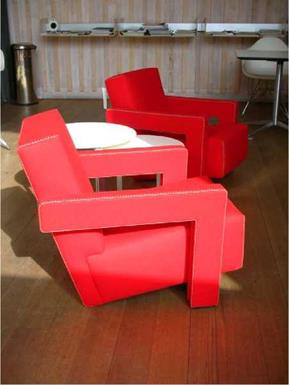In 1901, American architect Frank Lloyd Wright (1869-1959) gave a talk at a meeting of

 |
the Chicago Society of Arts and Crafts entitled "The Art and Craft of the Machine." He declared that the furniture he designed was suitable for machine production and that machines should be abhorred only when they were set to replicate nonmechanical tasks such as carving. He wanted furniture to be machine made and affordable for a large number of people (Figure 10.53). Frank Lloyd Wright became an eminent American designer who created unique furniture pieces for most of his buildings. So important is his work that efforts have been made to preserve much of it, including the furniture and decorative elements within his buildings.
Between 1895 and 1915, Grand Rapids, Michigan, was commonly referred to as the "furniture capital of the world." There, American furniture companies such as the Limbert Furniture Company, Stickley Bros. Company, The Guild, the Michigan Chair Company, and the Grand Rapids Chair Company developed. Several years later, Steelcase, Herman Miller, and Hayworth emerged as enormously successful furniture companies. Originally producing furniture for the residential market, Herman Miller became the second largest
office furniture producer in the United States. The company promoted its association with emerging designers Charles and Ray Eames and George Nelson. Steelcase developed a reputation for producing well-engineered office equipment and furniture, becoming the largest furniture company producing office systems and chairs for distribution throughout the world.
There was a steady advance throughout the Machine Age (1910-1945) in the design of machines, trains, boats, planes, and cars. However, the most profound development during this period was the advancement of science, citing the work and influence of individuals such as Albert Einstein and Max Planck. Science, engineering, and machines dominated all aspects of society, fueled in part by the Second World War and military advances from the war effort. New material technologies came into being with the use of tubular steel, bent plywood, and an array of new plastics. No longer was the world carved into unreachable quadrants. When new art movements emerged, they quickly spread throughout the world.
Fine art trends exploded. The major art trends that rose after impressionism were cubism, surrealism, futurism, and fauvism.
With the rise of the Machine Age came Art Deco, which takes its name from the 1925 L’Exposition Internationale des Arts Decoratifs et Industriels Modernes. Arguably the most significant project during the Machine Age was the design and fabrication of the French ocean liner Normandie. Work on the Normandie began in 1935, and no expense was spared, calling into service many cabinetmakers, metalworkers, silversmiths, glass workers, and ceramic craftsmen in France. Furniture designed during this period often had inlay work with curves while creating surface planes. From this time onward, design in general took on a new direction—one that embraced the machine and new emerging technologies.
 The furnishings of Le Corbusier (1887-1965) and his collaborators, Pierre Jeanneret (1896-1967) and Charlotte Perriand (1903-1999), exemplified a new spirit in furniture design that drew inspiration from the machine and industrialization. Designed for the Salon d’Automne in Paris in 1929 and the Pavilion de l’Esprit Nouveau, the Chaise Longue (1928), the Grand Confort chair (1928), and the Siege de Repos all embraced a machine aesthetic of chrome-plated tubular steel and leather, drawing on ideals of modernism and theories outlined in Le Corbusier’s book,
The furnishings of Le Corbusier (1887-1965) and his collaborators, Pierre Jeanneret (1896-1967) and Charlotte Perriand (1903-1999), exemplified a new spirit in furniture design that drew inspiration from the machine and industrialization. Designed for the Salon d’Automne in Paris in 1929 and the Pavilion de l’Esprit Nouveau, the Chaise Longue (1928), the Grand Confort chair (1928), and the Siege de Repos all embraced a machine aesthetic of chrome-plated tubular steel and leather, drawing on ideals of modernism and theories outlined in Le Corbusier’s book,
Towards a New Architecture (Figures 10.54 and 10.55).
Gerrit T. Rietveld (1888-1964) was born in Utrecht, the Netherlands, and was trained as a cabinetmaker and an architect. He designed and fabricated his Red-Blue chair between 1917 and 1919 (see Chapter 4). In 1924, he designed the Schroder House in Utrecht. Rietveld designed and produced a great deal of furniture, nearly all of which embodied de Stijl principles, an approach in art and design based upon the abstraction of form and color.
Theo van Doesburg (1883-1931), considered the father of de Stijl, was concerned with concepts of pure abstraction and developed a number of architectural projects and cubist furniture designs. Throughout his career, Rietveld experimented with plywood, fiberboard, aluminum, bent
Figure 10.54 Tubular steel frame for Grand Contort, designed by
metal, and even with upholstery (Figure 10.56). Fauteuil Le Corbusier and Charlotte Perriand (1928). Courtesy of Cincinnati Art was originally designed in 1935 for the production of Museum (Change of Pace Exhibit, October 4, 1975-January 4, 1976).
|
|
|
|
Metz & Co. The armchair was made with a wood structure and wool upholstery with visible diagonal stitching.





